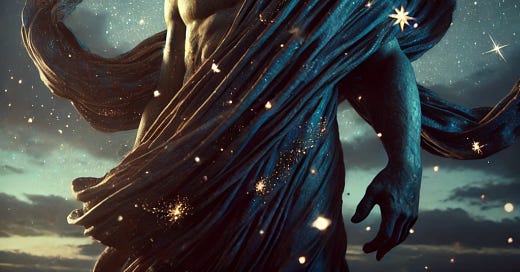Myth of the Day: Astraeus
Explore the celestial power and enduring legacy of a Titan who bridges the realms of stars and winds.
Region/Culture: Greece, Mediterranean
Mythos: Greek Mythology
Primary Type/Nature: Gods and Deities
Mythical Attributes: Associated with the stars and the astrological phenomena, as well as the winds.
Role in Mythos: Titan associated with the dusk, bridging the celestial and atmospheric phenomena through his lineage and deeds.
Relation to Humans: Astraeus represents the cosmic order through the movements of the stars and winds, which were critical in ancient navigation and agriculture. His progeny with Eos, including the winds and stars, directly affects human activities by controlling the weather and guiding night-time navigation.
In the annals of Greek mythology, where gods and mortals often blur into the canvas of the cosmos, Astraeus stands as a monumental figure, lesser known but crucial. His domain stretches across the twilight sky, bridged with the stars and the whispered gusts of wind. He is depicted in ancient relics as a figure robust in form, draped in a cloak that seems stitched from the very fabric of night—a tapestry of twinkling stars and swirling winds, a visual testament to his command over the celestial and atmospheric realms.
Astraeus, a Titan born of Crius and Eurybia, symbolizes the dusk and the critical transition from day to night. His origins tie him to the primal forces of the world, where his lineage suggests a natural authority over aspects of the world often considered both unpredictable and omnipresent. With Eos, the dawn, as his consort, the mythology of Astraeus is as much about balance and transition as it is about power. Together, they embody the ceaseless cycle of day and night. Their union is not just matrimonial but cosmically significant, giving birth to the Anemoi—the winds—and the stars, entities that govern both the natural world and human activity.
The tales of Astraeus are not fraught with the usual drama of trickery and strife that characterize many Greek myths. Instead, they speak to a foundational role in the natural order. For instance, each of his children with Eos holds sway over a particular aspect of human life and nature. Boreas, the north wind, brings the cold winter air; Zephyrus, the west wind, heralds the late summer breezes; and Eosphorus, the morning star, signals the dawn, guiding sailors and farmers alike.
In terms of powers, Astraeus wields control over the stars and the winds, an ability that allows him to influence everything from weather patterns to agricultural success and navigation. His influence stretches from the whispered guidance to sailors setting their courses by the stars, to the farmer praying for just the right amount of rain or wind for their crops. However, like many mythological figures, his abilities are a double-edged sword. The very winds that can fill a sail can also capsize a ship; the stars that guide can also mislead.
His weaknesses, though seldom spoken of, lie in the realm of his Titan heritage—destined always to be overshadowed by the Olympian gods who rose to power after him. Astraeus, while powerful, remains bound to the cycles and duties assigned to him, a cog in the cosmic machine, unable to transcend his primordial roots or the inevitable flow of day into night and back again.
Through the story of Astraeus, one glimpses not just the might of a god, but the essential, enduring rhythms of the world that were once considered divine. His story, though quieter than those of Zeus or Hera, is no less vital to the understanding of a world where every dusk and every dawn remind us of the everlasting dance between day and night, overseen by a god whose very essence is woven into the coming and going of light.
Suggested Further Reading
Explore more myths and wonders by visiting godsandmonsters.info.
Enjoy mythic tales on the move with our podcast, Five Minute Mythology.





